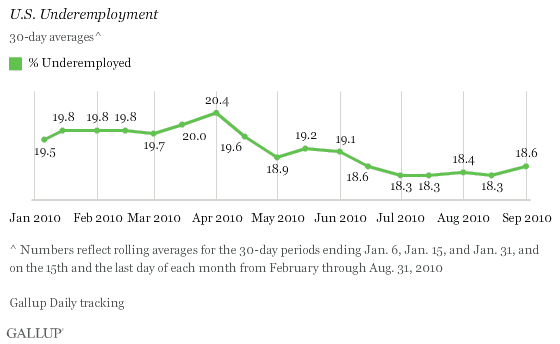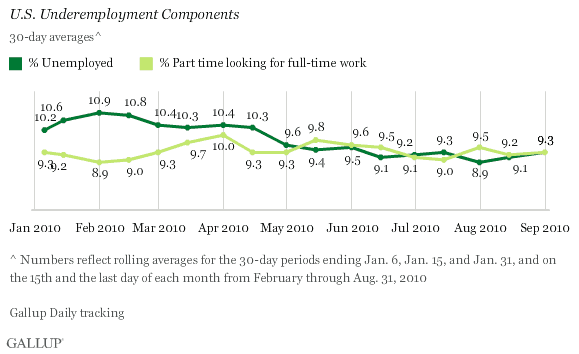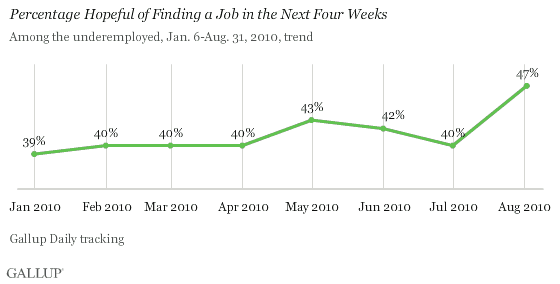PRINCETON, NJ -- Underemployment, as measured by Gallup, was 18.6% in August, up from 18.4% at the end of July. Underemployment peaked at 20.4% in April and has yet to break below 18.3% this year.

Gallup's underemployment measure estimates the percentages of American workers who are either unemployed or working part time but wanting full-time work. It is based on more than 15,000 phone interviews with U.S. adults aged 18 and older in the workforce, collected over a rolling 30-day period and reported daily and weekly. Gallup's results are not seasonally adjusted and tend to be a precursor of government reports by approximately two weeks.
Unemployment Rate Is Going Up
The unemployment rate component of Gallup's underemployment measure increased from 8.9% at the end of July to 9.1% in mid-August, and now stands at 9.3%. This increase has been partially offset as the percentage of employees working part time but wanting full-time work declined from 9.5% at the end of July to 9.3% at the end of August.

Job Hope Hits New 2010 High
Despite declining consumer confidence and negative news about the job market nationally, 47% of underemployed Americans are "hopeful" that they will be able to find a job in the next four weeks -- a new high for 2010.

Friday's Jobs Numbers Likely to Worsen
It may seem counterintuitive that hope among the underemployed of finding a job is increasing even as unemployment and underemployment are rising. However, Americans should not forget that even when unemployment is high, many companies are hiring, and many employees are changing jobs, particularly at this time of year. As a result, job activity can create job hopes.
On the other hand, Wednesday's ADP report suggests private-sector employment declined last month. Similarly, Gallup's underemployment measure and its unemployment rate show the job situation worsening. Gallup modeling suggests it is likely that the U.S. unemployment rate will increase to between 9.6% and 9.8% when the government reports the August numbers on Friday.
Worse yet, Gallup's job data show that 28% of Americans aged 18 to 29, 24% of those with no college education, and 22% of women were underemployed in August. This is not good news for retailers hoping that Christmas holiday sales will be better than those of back-to-school, or for politicians hoping to be re-elected in November.
Gallup.com reports results from these indexes in daily, weekly, and monthly averages and in Gallup.com stories. Complete trend data are always available to view and export in the following charts:
Daily: Employment, Economic Confidence and Job Creation, Consumer Spending
Weekly: Employment, Economic Confidence, Job Creation, Consumer Spending
Read more about Gallup's economic measures.
Results are based on telephone interviews conducted as part of Gallup Daily tracking survey Aug. 2-31, 2010, with a random sample of 17,917 adults, aged 18 and older, living in all 50 U.S. states and the District of Columbia, selected using random-digit-dial sampling.
For results based on the total sample of national adults, one can say with 95% confidence that the maximum margin of sampling error is ±1 percentage point.
Interviews are conducted with respondents on landline telephones and cellular phones, with interviews conducted in Spanish for respondents who are primarily Spanish-speaking. Each daily sample includes a minimum quota of 150 cell phone respondents and 850 landline respondents, with additional minimum quotas among landline respondents for gender within region. Landline respondents are chosen at random within each household on the basis of which member had the most recent birthday.
Samples are weighted by gender, age, race, Hispanic ethnicity, education, region, adults in the household, cell phone-only status, cell phone-mostly status, and phone lines. Demographic weighting targets are based on the March 2009 Current Population Survey figures for the aged 18 and older non-institutionalized population living in U.S. telephone households. All reported margins of sampling error include the computed design effects for weighting and sample design.
In addition to sampling error, question wording and practical difficulties in conducting surveys can introduce error or bias into the findings of public opinion polls.
For more details on Gallup's polling methodology, visit https://www.gallup.com/.
